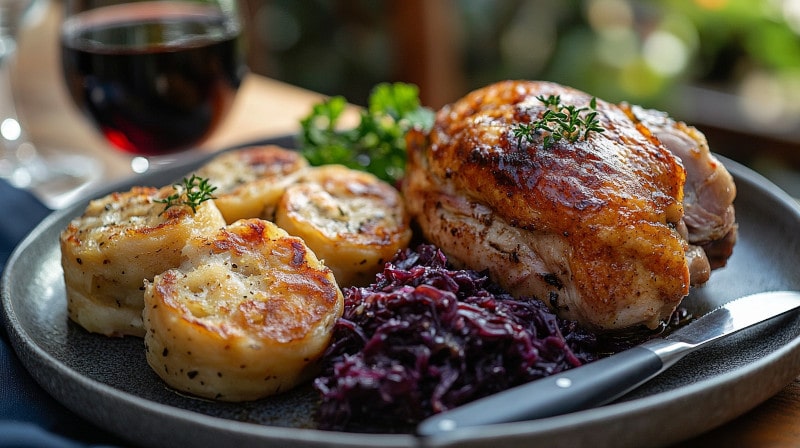A festive dish with perfect wine pairing
This roast duck with red cabbage and napkin dumplings is a classic festive dish with intense flavours. The crispy skin of the duck, the sweet and spicy red cabbage and the fluffy napkin dumplings form a harmonious combination of roasted flavours, fruity acidity and creamy texture. The perfect wine accompaniment is a Blaufränkisch with dark fruit and fine spice, which emphasises the flavours of the duck and complements the fruitiness of the red cabbage with its acidity.
Why do the following wines go perfectly with this meal?
An intense dish such as roast duck with red cabbage requires a wine that picks up on the spicy roast flavours as well as the fruity and slightly sweet components. The crispy skin and juicy meat require a good structure and fine tannins that blend elegantly into the flavour.
A Blaufränkisch DAC from Burgenland is ideal for this. It has a spicy, dark berry fruit, lively acidity and velvety tannins that enhance the roasted flavours of the duck and at the same time harmonise the sweetness of the red cabbage. The earthy notes and subtle peppery flavours provide a depth of flavour that makes the dish even more complex.
Alternatively, red wines with a structured acidity, fine spiciness and dark fruit, which ideally complement the flavours of the dish, are also suitable.
Another 5 wine recommendations for this pairing
1st Pinot Noir from Burgundy (France, AOC)
This wine is known for its elegant fruit, fine acidity and silky tannins, which do not overpower the juicy duck meat but complement it perfectly. The red berry flavours and light earthy notes go perfectly with the spiciness of the red cabbage.
2. syrah from the northern Rhône (France, AOC)
A Syrah from the northern Rhône impresses with black fruit, peppery notes and a fine acidity structure that enhance the flavour of the crispy duck. The subtle smoky note from the ageing process gives the dish additional depth.
3rd Nebbiolo from Barolo (Italy, DOCG)
A mature Barolo has intense tannins, high acidity and aromas of cherry, liquorice and violet. This structure harmonises with the fatty duck, while the acidity perfectly absorbs the red cabbage.
4. tempranillo from the Rioja Reserva (Spain, DOCa)
This wine offers red and dark berry fruit, velvety tannins and fine vanilla and spice notes, which interact perfectly with the duck and the slightly sweet red cabbage.
5th Zweigelt Reserve from Lower Austria (Austria, DAC)
With its soft tannins, spicy fruit and elegant structure, Zweigelt complements the duck in an accessible and harmonious way. The fine cherry and berry flavours balance the dish perfectly.
The recipe:
Roast duck with red cabbage & napkin dumplings
Cooking utensils
- 1 Cutting board & knife
- 1 Frying pan & roaster
- 1 Wooden spoon for stirring
- 1 Pot for the red cabbage
- 1 Cooking pot for the dumplings
Ingredients
For the duck:
- 2 Duck breasts approx. 250 g each
- Salt & pepper to taste
- 1 teaspoon thyme Dried
- 1 Tbsp honey
- 1 Tbsp clarified butter
For the red cabbage:
- 300 g Red cabbage finely chopped
- 1 Apple grated
- 1 Onion finely diced
- 1 tablespoon of goose fat or butter
- 2 tablespoon apple cider vinegar
- 100 ml Red wine
- 1 tsp sugar
- Salt & pepper to taste
For the napkin dumplings:
- 200 g stale white bread diced
- 150 ml Milk
- 1 Egg
- 1 Tbsp butter melted
- 1 tablespoon parsley chopped
- Salt & nutmeg to taste
Preparation
Prepare & roast the duck:
- Make a diamond-shaped incision in the skin of the duck breasts, but do not cut into the flesh.
- Season with salt, pepper and thyme.
- Place the duck breasts skin side down in a cold frying pan and cook over a medium heat until golden brown and crispy (approx. 8 minutes).
- Turn and fry for a further 3 minutes on the meat side.
- Cook in a preheated oven at 160 °C for 15 minutes.
- Before serving, brush with honey and briefly place under the grill.
Braise the red cabbage:
- Heat the goose fat in a pan and sauté the onions.
- Add the red cabbage and grated apple and sauté briefly.
- Deglaze with apple cider vinegar, then add red wine, sugar, salt & pepper.
- Simmer over a low heat for 40 minutes, stirring occasionally.
Prepare the napkin dumplings:
- Pour warm milk over the white bread cubes and leave to infuse for 10 minutes.
- Stir in the egg, melted butter, parsley, salt and nutmeg.
- Shape the mixture into a roll, wrap in cling film and aluminum foil.
- Cook in boiling water for 30 minutes.
Serve:
- Slice the duck breasts and arrange on the plate.
- Serve with red cabbage and napkin dumplings.
- Garnish with fresh herbs.
Recommended side dishes
- Marinated cranberries as a fruity addition
- Potato gratin with thyme
- Brussels sprouts with bacon

